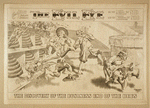Today's quote comes from Charles Chesnutt's short story "The Goophered Grapevine." This story was first published in the Atlantic Monthly in 1887, and was reprinted in Chesnutt's collection The Conjure Woman (1899). In this tale, a plantation owner has the conjure woman, Aunt Peggy, put a "goopher" on his scuppernong vines to prevent them from being eaten by slaves from other plantations in the vicinity. The "goopher" is supposed to cause those who pilfer the grapes to die within twelve months. Unfortunately, one of his own slaves, Henry, eats the scuppernongs. While the overseer takes Henry to Aunt Peggy to remove the goopher, she is only able to partialy remove it. Henry's state of heath begins to follow the life cycle of the grapes--he waxes in the summer and wanes in the winter. His master, seeing an opportunity to capitalize on this new situation, begins to sell him during his waxing period and re-purchase him during his waning months. Gradually, Henry begins to fade away in a story that is an allegory of slavery's misuse and destruction of both land and bodies. This quote describes Henry's new life cycle in terms of the growth of his hair. While initially "bald as a sweet potato" as the story goes, he begins to exhibit hair that resembles the grape vines--unmanageable "grapy hair," the "biggest hair on the plantation":
"So Henry 'n'int his head wid de sap out'n de big grapevime des ha'f way 'twix' de quarters en de big house, en de goopher nebber wuk agin him dat summer. But de beatenes' thing you eber see happen ter Henry. Up ter dat time he wuz ez ball ez a sweeten' 'tater, but des ez soon ez de young leaves begun ter come out on de grapevimes, de ha'r begun ter grow out on Henry's head, en by de middle er de summer he had de bigges' head er ha'r on de plantation. Befo' dat, Henry had tol'able good ha'r 'roun' de aidges, but soon ez de young grapes begun ter come, Henry's ha'r begun to quirl all up in little balls, des like dis yer reg'lar grapy ha'r, en by de time de grapes got tipe his head look des like a bunch er grapes. Combin' it didn' do no good; he wuk at it ha'f de night wid er Jim Crow, en think he git it straighten' out, but in de mawnin' de grapes 'ud be dere des de same. So he gin it up, en tried ter keep de grapes down by havin' his ha'r cut sho't [...]
But de mo's cur'ouses' thing happen' in de fall, when de sap begin ter go down in de grapevimes. Fus', when de grapes 'uz gethered, de knots begun ter straighten out'n Henry's ha'r; en w'en de leaves begin ter fall, Henry's ha'r 'mence ter drap out; en when de vimes 'uz bar', Henry's head wuz baller 'n it wuz in de spring, en he begin ter git ole an stiff in de j'ints ag'in, en paid no mo' 'tention ter de gals dyoin'er de whole winter. En nex' spring, w'en he rub de sap on ag'in, he got young ag'in, en so soopl en libely dat none er de young niggers on de plantation couldn' jump, ner dance, ner hoe ez much cotton ez Henry.
--Charles Chesnutt, "The Goophered Grapevine," In The Conjure Woman, Ed.Richard H. Brodhead
Subscribe to:
Post Comments (Atom)






No comments:
Post a Comment